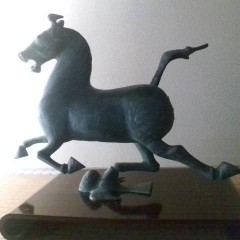日本の部屋作りは面白いです。アメリカの家は無駄が多いです。知り合いの何人かの家が馬鹿でかくて、1年に一度も使わない部屋がある。アメリカはそれだけ広くて、余裕があるわけ。日本は逆に狭くて、例えば、こういう旅館の場合は同じ部屋はリビングとして、そして食事にも寝る時にも使う。効率良いといえば良いですね。しかし、日本の部屋はいくらでも狭くて、いくらでも効率を優先的に考えても、思い切り無駄の場所は必ずある:床の間。すごい不思議な存在です。
そして、その床の間に何を置くか、何を飾るか、いつも不思議に思っています。何でもありという訳に行かないと思いますが、どういうルールがあるでしょうか?書画と生け花が基本ではないかと思いますが、亀清旅館の客室の床の間は大体、壁に何かの江がかけてあって、下に何かのオブジェが置いてある。
以前は風呂前の養老の間の床の間のオブジェは「燕を踏んでいる馬」の小さな銅像だとお客さんに気付かされました。そのお客さんは詳しい事が知らなかったけど、とにかくどっかからな有名な銅像だと言う話になっていた。まあ、信州で馬刺しが名物になっているから何か「長野」と「馬」のつながりかな・・・と思いました。
そして、先日に泊まったお客さんが、「あっ、馬騰飛燕だ!私は本物を見に行った事がある!」と仰った。これでこの銅像の有らいが分かると私が喜んで、期待して聞いた:「本物はどこですか?」
どこだと思いますか?ヒント:長野じゃない。日本でもない。中国だ!何百年前に死んじゃった王様のお墓に。
ショックや!何で日本じゃない者は日本の床の間においてある?まあ、こうやってこのお客さんが感心して喜んでくれたけど、私が来て4年間の間で初めてでした。もっと一般な人に関心となる物の方が良いのではないかな?
とは、私の床の間の悩みです。
It always amazes me how no matter how constricted a traditional room is in Japan due to the lack of space, without fail there is space set aside for the tokonoma alcove. I mean, here you have a room that can be a combined living, dining and bed-room, totally maxing out the functionality (compared with houses in the States that are so huge, they have rooms that are hardly ever used!), yet you have this one section that has absolutely no practical function. But that's what makes a room a traditional "Japanese" room, and all of our guest rooms here in Kamesei Ryokan have a tokonoma.
I have been curious as to what the "rules" are for a tokonoma. I think the orthodox style is to have a caligraphy scroll hanging on the wall with a ikebana display set on the base. Most of ours have some painting (deer, Mt. Fuji, koi, etc.) and some "object" set on the base. One of our rooms, Yoro, has this bronze statue of a horse stepping on a swallow. I had never noticed it before until one of our guests said, "Hey, that's a copy of the famous horse-stepping-on-a-swallow statue!" When I asked for details, all I got was a "I dunno, but it's famous."
So, imagine my surprise when one of our recent guests said, "I've been to see the original statue." Initially, I had thought that since basashi (raw horse meet) is a delicacy, that horses and Nagano have a historical connection, and that the swallow horse is related to that Nagano connection somehow. So I was a little chagrined to learn that the original is not from Nagano, nor even from Japan -- it's from China. It was a decoration in an ancient burial chamber for some emperor.
I'm glad one of our guests was pleased to see the statue, but that's the first time in the four years since I've come here. Wouldn't it be more appropriate to display something more people are familiar with, maybe something from Nagano or at least from Japan in our traditional Japanese tokonoma alcove? That's my tokonoma dilemma.




